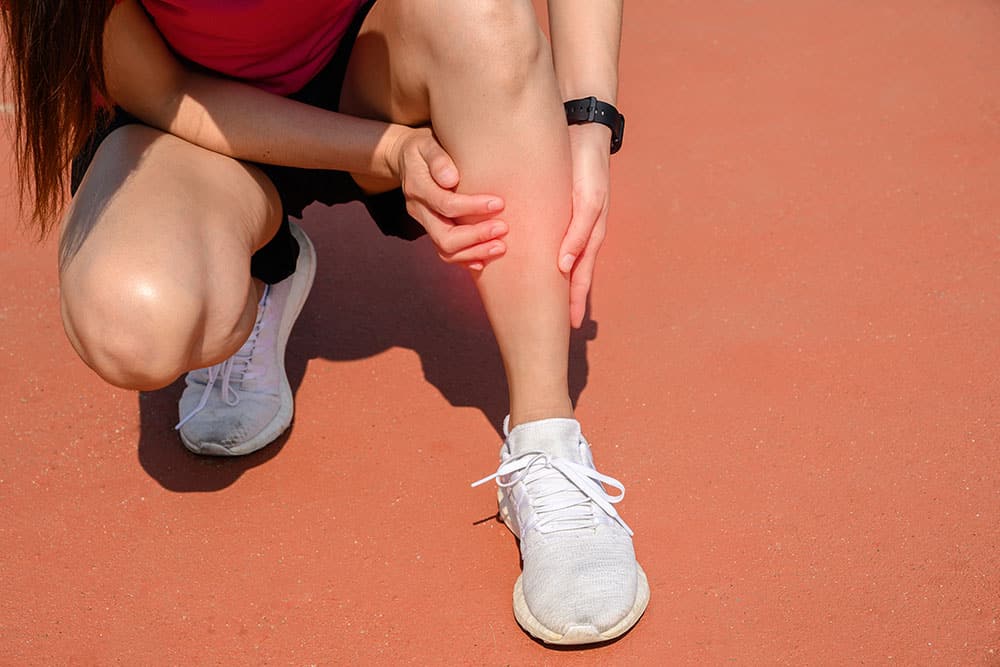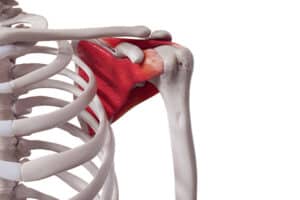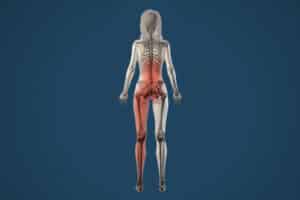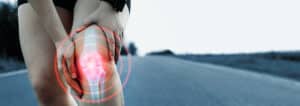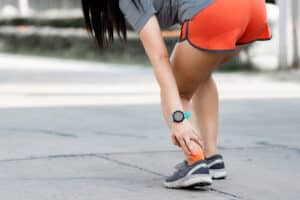The term “shin splints” is often viewed as a broad and inclusive phrase that encompasses various leg-related conditions. Shin splints, medically known as “idiopathic compartment syndrome” or “medial tibial stress syndrome,” are a common condition that affects athletes, runners, and even the average person who has suddenly increased their level of physical activity. The pain is usually felt along the inner edge of the shinbone (tibia) and can range from mild to severe. While rest and ice packs are often recommended for immediate relief, physiotherapy can play a crucial role in both treating and preventing shin splints. In this blog post, we will delve into how physiotherapy can assist in managing this condition.
Let’s First Talk About the Shinbone
The shinbone, also known as the tibia, is one of the two long bones located in the lower leg, between the knee and the ankle. The tibia is the larger and stronger of the two bones, with the other being the fibula. The tibia is situated on the inner side of the leg, and it is what most people commonly refer to when they talk about the “shin.” The tibia serves as an essential structural component for muscle attachment and is crucial for weight-bearing and movement.
What Are Shin Splints?
Before we discuss the role of physiotherapy, it’s essential to understand what shin splints are. They occur when there is excessive stress on the shinbone and the tissues that attach the shinbone to the muscles surrounding it. This stress causes inflammation and pain, making it difficult to walk, run, or engage in physical activities.
Determining whether you have shin splints often involves a combination of symptom recognition.
Different Types of Shin Splints
Shin splints typically manifest in different forms based on the area and tissues involved in the lower leg. Here are the different types of shin splints:
1. Medial Shin Splints
Location: Inner side of the shin.
Common in: Runners and dancers.
Causes: Overpronation (flat feet), improper footwear, or excessive stress on the shinbone and the tissues attaching the shinbone to the muscles surrounding it.
2. Anterior Shin Splints
Location: Front outside part of the shin.
Common in: Athletes who engage in activities with quick starts and stops, like soccer or basketball.
Causes: Stress and fatigue in the tibialis anterior muscle, often due to a sudden increase in intensity or frequency of physical activity.
3. Posterior Shin Splints
Location: Inner part of the shin, towards the back.
Common in: Athletes with muscular imbalances or instability in their legs.
Causes: Overuse of the tibialis posterior muscle, which helps in controlling the motion of the foot.
4. Stress Fracture-Related Shin Splints
Location: Can occur in various parts of the shin.
Common in: High-impact sports athletes, like runners.
Causes: Repetitive stress causing tiny cracks in the shinbones.
5. Compartment Syndrome-Related Shin Splints
Location: Various compartments in the shin area.
Common in: Athletes involved in activities requiring repetitive impacts, like running.
Causes: Increased pressure within the muscles leading to pain and swelling.
Shin Splints: Common Symptoms
Localized Pain: One of the most telling signs of shin splints is a dull, aching pain along the inner part of the lower leg, particularly along the shinbone (tibia).
Tenderness and Swelling: The area around the shinbone may be tender to the touch and could show signs of mild swelling.
Pain During or After Activity: The pain typically worsens during physical activities like running, jumping, or walking, and may subside during rest. However, as the condition progresses, the pain may persist even at rest.
Muscle Stiffness: Some people experience stiffness in the muscles around the shinbone, which can make movement uncomfortable.
Numbness or Weakness: In more severe cases, you may experience numbness or weakness in the feet, although this is less common.
Shin Splints: Common Causes
Overuse or Sudden Increase in Activity
One of the most common causes of shin splints is overuse or a sudden spike in the level of physical activity. This is especially true for beginners who may not be accustomed to the stresses of running or other high-impact activities. The muscles, tendons, and bone tissue can become overworked due to increased activity, leading to pain and inflammation.
Running on Hard or Uneven Surfaces
The type of surface you run or exercise on can significantly impact your risk of developing shin splints. Hard surfaces like concrete can increase the stress on your lower legs, while uneven terrains can cause your foot to pronate or supinate excessively, leading to muscle imbalances.
Inadequate Footwear
Wearing shoes that lack proper cushioning and support can contribute to shin splints. Old or worn-out shoes may not provide adequate shock absorption, increasing the stress on your shinbone and the surrounding muscles.
Muscle Imbalances
Muscle imbalances in the legs can also be a contributing factor. For example, if the muscles in the front of your leg are significantly stronger than those in the back, this imbalance can lead to increased stress on the shinbone.
Poor Biomechanics
Poor biomechanics, such as overpronation (excessive inward rolling of the foot) or oversupination (excessive outward rolling of the foot), can contribute to the development of shin splints. These conditions can alter the way your weight is distributed as you move, placing extra stress on your shinbone.
Lack of Warm-up or Cool-down
Skipping the warm-up or cool-down phase of your workout can make your muscles more susceptible to injury, including shin splints. A proper warm-up increases blood flow to the muscles, making them more flexible and less prone to injury. Similarly, a cool-down helps to gradually reduce your heart rate and relax your muscles, reducing the risk of muscle strain and shin splints.
Previous Injuries
If you’ve had a previous injury in the lower leg, ankle, or foot, you may be more susceptible to developing shin splints. Scar tissue from previous injuries can affect muscle function and biomechanics, contributing to the condition.
Body Weight and Physical Condition
Being overweight can put additional stress on your legs, increasing the risk of shin splints. Similarly, poor physical condition can make your muscles more susceptible to the stresses of exercise, leading to a higher likelihood of developing the condition.
Understanding these common causes can help in both the prevention and treatment of shin splints. If you’re experiencing symptoms, it’s advisable to consult your physiotherapist for a proper diagnosis and treatment plan.
How Can Physiotherapy Help with Shin Splints?
Analysis and Diagnosis
A physiotherapist will start by conducting a thorough assessment. This helps in diagnosing the severity of the condition and identifying the underlying causes.
Medical History: Your physiotherapist will ask about your exercise habits, the type of surfaces you run or exercise on, and any previous injuries you may have had.
Physical Examination: The physiotherapist will examine your lower leg, looking for signs of tenderness, swelling, or redness.
Imaging Tests: While not always necessary, imaging tests like X-rays or MRIs may be ordered to rule out other conditions like stress fractures.
Biomechanical Assessment: In some cases, a biomechanical assessment may be recommended to evaluate your posture, gait, and foot mechanics, which can contribute to shin splints.
Differential Diagnosis
It’s essential to rule out other conditions that may mimic the symptoms of shin splints, such as:
- Stress fractures
- Compartment syndrome
- Tendonitis
- Muscle strains
Shin Splints Treatment and Management
If diagnosed with shin splints, the initial treatment often involves rest, ice, compression, and elevation (RICE). Anti-inflammatory medications may also be prescribed for pain relief. Physiotherapy is commonly recommended for both treatment and prevention, as it addresses the underlying causes and helps in muscle strengthening and biomechanical corrections.
Personalized Physiotherapy Plan
Based on the assessment, a personalized treatment plan is designed to address the specific needs of the individual. This may include:
Pain Management: Techniques such as ultrasound therapy, electrical stimulation, and manual therapy can help in reducing pain and inflammation.
Strengthening Exercises: Targeted exercises are prescribed to strengthen the muscles around the shinbone, thereby reducing stress on it.
Stretching and Flexibility: Stretching exercises help in improving the flexibility of the muscles, which can prevent future occurrences.
Footwear Advice: Guidance on choosing the right footwear can significantly impact the distribution of force during physical activities.
Biomechanical Corrections
Physiotherapy also involves correcting biomechanical imbalances through techniques like orthotic prescription for foot alignment, taping, and posture correction.
Education and Prevention
Educating the patient about the condition, its causes, and preventive measures is an integral part of physiotherapy. This includes training schedules, warm-up and cool-down techniques, and lifestyle changes.
Shin Splints Healing Time
The healing time for shin splints can vary widely depending on several factors, such as the severity of the condition, the effectiveness of the treatment plan, and how well you adhere to it.
Factors Affecting Healing Time
Adherence to Treatment: Following the treatment plan diligently can significantly speed up recovery.
Activity Level: Resuming high-impact activities too soon can delay healing and may even worsen the condition.
Underlying Health Conditions: Conditions like poor circulation or chronic inflammation can extend the healing time.
Age: Older individuals may take longer to heal due to reduced regenerative capacity.
Preventive Measures for Faster Healing
Gradual Return to Activity: Once the symptoms have subsided, it’s crucial to return to your regular activities gradually to avoid recurrence.
Strength and Flexibility Training: Exercises to improve muscle strength and flexibility can help in faster recovery and in preventing future episodes.
Proper Footwear: Wearing shoes with good arch support and cushioning can aid in faster healing and prevent recurrence.
Physiotherapy Can Treat and Prevent Shin Splints
Shin splints can be a debilitating condition that hampers your ability to engage in physical activities. However, physiotherapy offers a holistic approach to not only treat the symptoms but also address the root causes to prevent future occurrences. If you’re struggling with shin splints, consider consulting a physiotherapist for a comprehensive treatment plan tailored to your needs.
Get started today!
Seeing a professional physiotherapy provider like Nova Physiotherapy for shin splints can offer expert care, personalized treatment, pain management, education, and a holistic approach to healing. If you’re considering physiotherapy, contact the friendly and experienced team at Nova Physiotherapy. We’re ready to help you on the road to better health.

